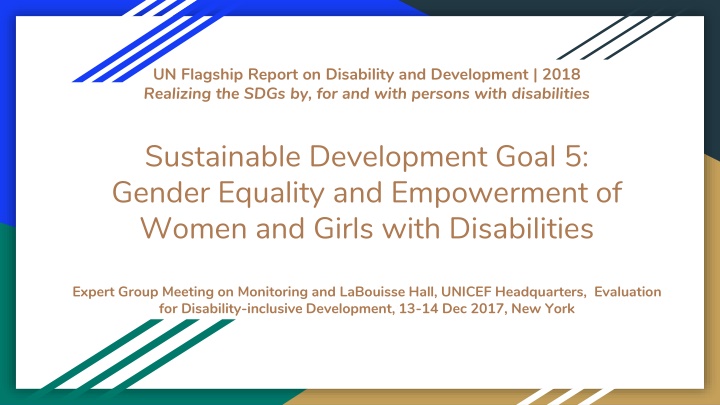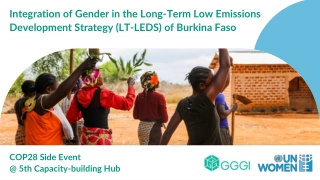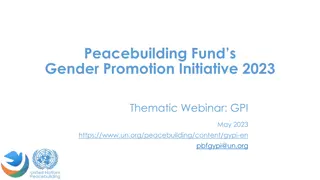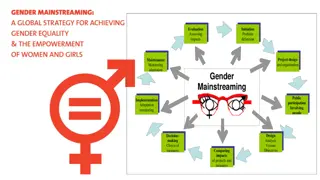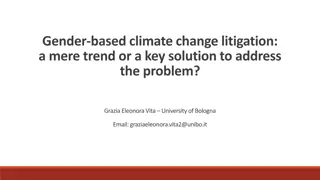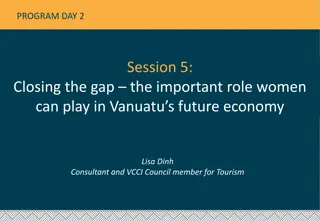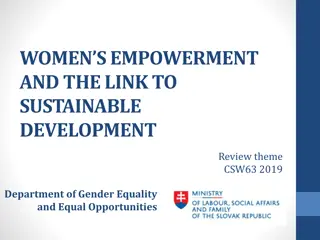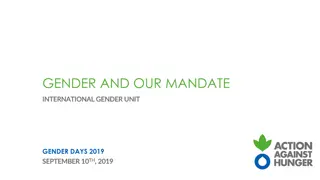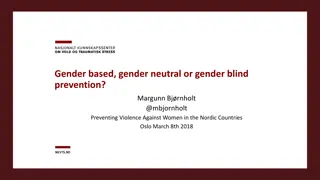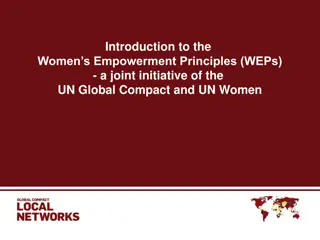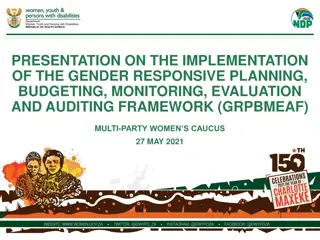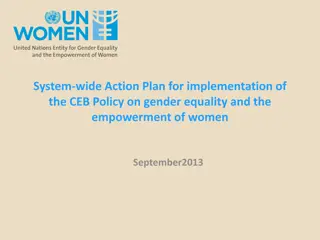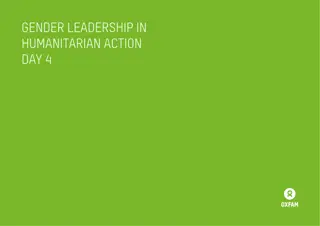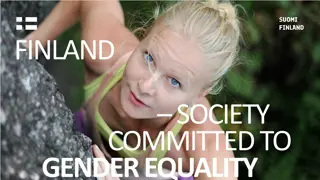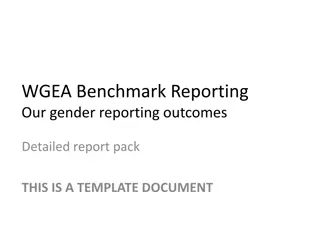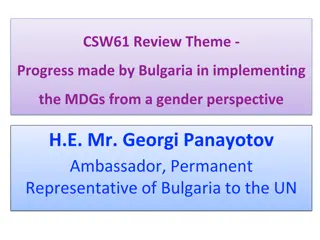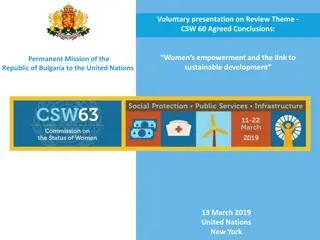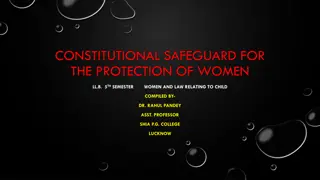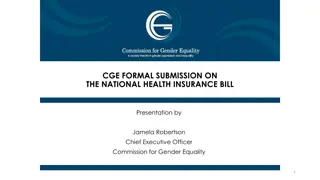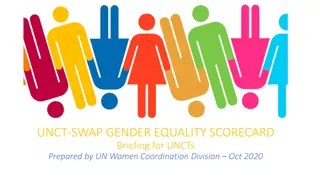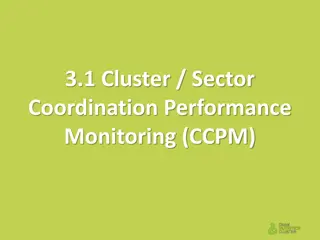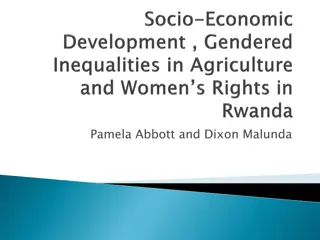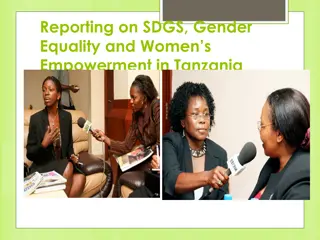Sustainable Development Goal 5: Gender Equality and Empowerment of Women with Disabilities
This report delves into achieving SDG 5 by and for women and girls with disabilities. It highlights the expert group meeting discussing monitoring and evaluation for disability-inclusive development. The report also outlines the task team, process, gaps, and challenges, emphasizing the importance of gender equality and empowerment.
Download Presentation

Please find below an Image/Link to download the presentation.
The content on the website is provided AS IS for your information and personal use only. It may not be sold, licensed, or shared on other websites without obtaining consent from the author.If you encounter any issues during the download, it is possible that the publisher has removed the file from their server.
You are allowed to download the files provided on this website for personal or commercial use, subject to the condition that they are used lawfully. All files are the property of their respective owners.
The content on the website is provided AS IS for your information and personal use only. It may not be sold, licensed, or shared on other websites without obtaining consent from the author.
E N D
Presentation Transcript
UN Flagship Report on Disability and Development | 2018 Realizing the SDGs by, for and with persons with disabilities Sustainable Development Goal 5: Gender Equality and Empowerment of Women and Girls with Disabilities Expert Group Meeting on Monitoring and LaBouisse Hall, UNICEF Headquarters, Evaluation for Disability-inclusive Development, 13-14 Dec 2017, New York
Overview Task Team Process, gaps, and challenges Content and Findings Way Forward
Task Team Coordinators Ola Abu Alghaib, Leonard Cheshire Disability Maribel Derjani-Bayeh, UN Women
Task Team Members Organizations of women with disabilities and other women s organizations Carolyn Frohmader, Women With Disabilities Australia (WWDA) Emma Pearce, Women s Refugee Commission Freyja Haraldsd ttir, TABU (grass-roots feminist women s group in Iceland) Mijoo Kim, Korea Disability Law Association / Women with Disabilities Arts and Cultural Network
Task Team Members Organizations of persons with disabilities Mary Keogh, Christian Blind Mission (CBM) Hannah Loryman, SightSavers Sophie Pecourt, Handicap International Making It Work project
Task Team Members Academic organizations and others Mona Par , University of Ottawa Rannveig Traustad ttir, University of Iceland Maria Soledad Cisternas Reyes, former Chair of the Committee on the Rights of Persons with Disabilities
Task Team Members United Nations Heidi Ullmann, United Nations Economic Commission for Latin America and the Caribbean (ECLAC) Victoria Lee, Office of the High Commissioner for Human Rights Other contributions: Emily Rubin, Intern, UN Women
Process, gaps, and challenges Looked at interlinkages between the targets of SDG 5 and other SDGs and chapters in the report Decided to address areas less likely to be addressed by other chapters Most input received addressed sexual and reproductive health and violence against women to be addressed in another chapter Sources included a few peer reviewed articles, and mostly research and publications produced by task team members or their organizations. Much of the evidence is qualitative Additional research: peer reviewed articles for the situation, and State Party reports for practices
Audience and focus of the chapter Audience: Those working in the areas of Rights and inclusions of persons with disabilities Gender equality and empowerment of women and girls Tried to: Organize the information around the targets of SDG 5 to better understand what we know about women and girls with disabilities compared to other women and girls Address the development and humanitarian continuum.
Would like your feedback on Noting the concerns with and gaps in evidence/information Whether to: Work with the evidence we have, including input to the prototype?? Focus on thematic areas where information is available? Look for additional quantitative data/evidence in UN and other international/regional organizations?
Options to collaborate and coordinate with other task teams Whether and how gender perspectives are being addressed in other chapters / under other SDGs Evidence or sources of evidence other teams can share as input for the chapter on SDG 5
SDG 5: Targets and Interlinkages 5.1 End all forms of discrimination against all women and girls everywhere Also related to the chapter SDG10 on inequalities Could also be addressed in all other chapters highlighting Any information available but not included in the chapter Good practices, and/or challenges including disaggregation by sex, age and disability
SDG 5: Targets and Interlinkages (continued) Proposed areas of focus: 5.5 Ensure women s full and effective participation and equal opportunities for leadership at all levels of decision-making in political, economic and public life Also related to the chapter on SDG 16: 16.7 Ensure responsive, inclusive, participatory and representative decision-making at all levels
SDG 5: Targets and Interlinkages (continued) Proposed areas of focus (continued) 5.4 Recognize and value unpaid care and domestic work through the provision of public services, infrastructure and social protection policies and the promotion of shared responsibility within the household and the family as nationally appropriate Also related to chapters on SDG 8 employment, and SDGs 1&2 social protection, and SDG 11 Accessible and inclusive cities and human settlements.
SDG 5: Targets and Interlinkages (continued) Proposed areas of focus (continued): 5.a Undertake reforms to give women equal rights to economic resources, as well as access to ownership and control over land and other forms of property, financial services, inheritance and natural resources, in accordance with national laws Also related to the chapters addressing employment, social protection, poverty and hunger, SDGs 6 and 7 on water and sanitation and energy
SDG 5: Targets and Interlinkages (continued) Coordination with other task teams 5.2 Eliminate all forms of violence against all women and girls in the public and private spheres, including trafficking and sexual and other types of exploitation 5.3 Eliminate all harmful practices, such as child, early and forced marriage and female genital mutilation Will be addressed in the chapter of ensuring access for persons with disabilities to sexual and reproductive health and reproductive rights Could also be addressed in the chapters on violence and access to justice, and disasters, humanitarian crisis and climate change.
SDG 5: Targets and Interlinkages (continued) Coordination with other task teams (continued). 5.6 Ensure universal access to sexual and reproductive health and reproductive rights as agreed in accordance with the Programme of Action of the International Conference on Population and Development and the Beijing Platform for Action and the outcome documents of their review conferences Will be the focus of the chapter of ensuring access for persons with disabilities to sexual and reproductive health and reproductive rights
SDG 5: Targets and Interlinkages (continued) Coordination with other task teams (continued). 5.b Enhance the use of enabling technology, in particular information and communications technology, to promote the empowerment of women Could be addressed in the chapters on ICTs / Assistive Devices, and Means of implementation: International cooperation, capacity building, technology and partnerships.
Introduction to the Topic In The 2030 Agenda resolves to Achieve gender equality and empowerment of all women and girls Explicitly recognizes need to empower persons with disability Increase in investments to close the gender gap and strengthen support for institutions in relation to gender equality and the empowerment of women. The 2030 Agenda Opportunity to for the empowerment of women and girls with disabilities Most targets with specific references to disability also include reference to gender/women/sex
Introduction to the topic (continued) Tried to address Other areas of intersectionality: Age, ethnicity, refugee status, urban/rural. Gender equality: Women and girls with disabilities and men and boys with disabilities Empowerment of women: women with disabilities compared to other women
International normative framework CEDAW, CRPD, CRC, and other human rights treaties General Comments and Recommendations Beijing, 2030 Agenda Outcomes of global conferences New Urban Agenda, Addis Ababa Action Agenda Sendai Framework for Disaster Risk Reduction Charter on the Inclusion of Persons with Disabilities in Humanitarian Action
International normative framework (continued) Selected United Nations resolutions General Assembly, Human Rights Council, Security Council, and Economic and Social Council, including Implementation of the Convention on the Rights of Persons with Disabilities and the Optional Protocol thereto: situation of women and girls with disabilities Commission on the Status of Women Agreed Conclusions including 2013, 2016, 2017
International normative framework (continued) Regional Conventions, Strategies and Plans Inter-American Convention Continental Plan for African Decade Incheon Strategy European Strategy
Situation of Women and Girls with Disabilities Status and Trends
5.1 End all forms of discrimination against all women and girls everywhere Intersection of gender and disability Women and girls with disabilities face greater discrimination and exclusion from society than women without disabilities, and men with disabilities.
5.1 End all forms of discrimination against all women and girls everywhere (continued) These manifest in Education, employment, income, access to health services, including gynaecological services Marriage, autonomy over sexual and reproductive health and rights. Sports, coverage in the media, etc. Higher incidence of violence and abuse (gender based?) Note: Evidence varies by type of disability, and other factors such as ethnicity, age.
5.4 Recognize and value unpaid care and domestic work through the provision of public services, infrastructure and social protection Women and girls with disabilities Less likely to be employed More likely to be underemployed (working part time instead of full time) Older women with disabilities face even higher rates of un/under employment.
5.4 Recognize and value unpaid care and domestic work through the provision of public services, infrastructure and social protection (continued) Women with disabilities are more likely to be economically unstable than men with disabilities, and women without disabilities More likely to live in poverty Often rely on government support to supplement income More likely to face housing insecurity and homelessness Access to fewer resources and support networks Overall lower quality of life
5.5 Ensure womens full and effective participation and equal opportunities for leadership Limited disaggregated data available on women with disabilities in political leadership roles Often where women with disabilities are represented in parliament, it is as a result of quote systems where both persons with disabilities and/or women are given certain numbers of seat allocations. Without adequate representation of women with disabilities, their voices and experiences are not adequately reflected.
Good practices and policy trends Overview Not a very clear trend or impact Inclusion of women among other women groups of women or population groups Mainstreaming of gender in initiatives related to the inclusion of persons with disabilities Disability inclusion gender equality and empowerment of women Initiatives targeting women and girls with disabilities
Good practices and policy trends State Parties Still reviewing the information from State Party reports to the Committee on the Rights of Persons with Disabilities Opportunities for women with disabilities to access loans and allowing repayment installments (Thailand) Some States include gender equality and empowerment of women in their strategies and/or frameworks for the inclusion of persons with disabilities in international cooperation (including Australia and the United Kingdom)
Good practices and policy trends (continued) Civil Society Organizations, including Organizations of Women with Disabilities Handicap International: Making It Work Initiative on good practices to address violence against women with disabilities Women Enabled International: Mapping and support to and capacity building of grassroots organizations Women s Refugee Commission: Strengthening Networks of Women with Disabilities in Humanitarian Action Mobility International USA: Leadership: Women s Institute on Leadership and Disability (WILD)
United Nations Activities UNICEF: Address barriers girls with disabilities face in access to Water, Sanitation and Hygiene (Cambodia, Jordan, Tanzania) UNDP: Engagement of women with disabilities in development policy making (Turkmenistan). UNFPA: Global initiative WE DECIDE to promote gender equality and advocate for the end of sexual violence
United Nations Activities (continued) UN Women, supported Support participation of women, youth and persons with disabilities to participated in electoral processes, including as candidates (Tanzania) Including gender perspectives in s disability policy (Morocco) Participation of women with disabilities in the development of the National Action Plan for Security Council resolution 1325, and propose disaggregation by disability (Colombia).
Concluding remarks Increased attention to issues related to violence against women with disabilities and sexual and reproductive health Gaps remain Most initiatives reported mention women and girls with disabilities, but it is not if these: Benefit women and /or girls Target women and/or girls Address gender equality
Concluding remarks (continued) Gaps remain Available data and evidence: Rarely analysed and reported by sex and disability, Most either on persons with disabilities or women Evidence on thematic areas, in particular under SDG 5
Way forward Include: Increased participation, leadership and empowerment of women and girls with disabilities Improved data disaggregation on gender, disability and age Disability and gender mainstreaming in policy development, financing and implementation Development of a gender and disability monitoring mechanism cross cutting issues across other goals. Strong political will
5.2 Eliminate all forms of violence against women and girls. Women and girls with disabilities are at a heightened risk of physical, sexual and emotional violence than women without disabilities and men with disabilities. Unequal power relations Perception that women and girls with disabilities are unable or unwilling to reveal abusers Devalued sense of self Women with disabilities who experience violence often do not seek either treatment or redress Fear of stigma Retaliation Lack of awareness of rights Often financially or emotionally dependant on their abusers Lack alternative living arrangements
